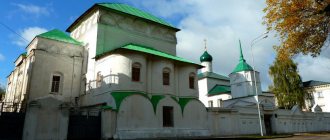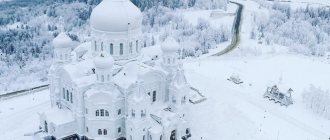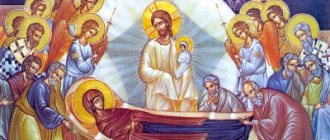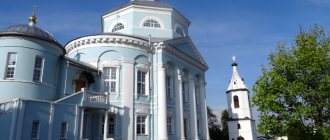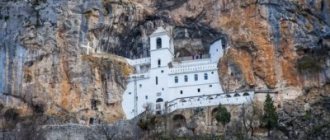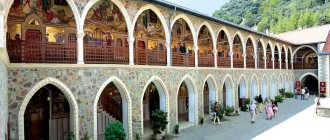By the end of the 16th century, a significant monastic city arose on the shores of Lake Siverskoye, comparable in number of stone buildings to the Trinity-Sergius Monastery. Inside its stone walls there are nine stone churches, a bell tower, a treasury chamber, a cookhouse, and glaciers. The monastic cells and the household courtyards surrounding the monastery were initially made of wood, and they were inhabited by numerous artisans who worked for the monastery: icon painters, silversmiths, woodcarvers, and blacksmiths. According to the inventory of 1601, about 180 brethren lived in the Kirillovsky Monastery.
History of the monastery
The Kirillo-Belozersky Monastery was founded by the monk of the Moscow Simonov Monastery Kirill in 1397. He managed the monastery until his death - more than 30 years. The first stone building of the monastery was the Assumption Cathedral, built in 1497, and in the 16th century the Ivanovo Monastery was built next to it.
The monastery grew rich and expanded - princes and kings did not skimp on donations and contributions. In 1557, there was a big fire in the monastery, but many stone buildings survived, and in 1600 the monastery was surrounded by a stone wall with eight towers.
During the Polish-Lithuanian invasion, the Kirillo-Belozersky Monastery resisted the enemy. For the first time, intervention detachments appeared in Belozerye in 1612: in August of that year they approached the walls of the monastery, but did not dare to launch a direct assault, but only destroyed the monastery courtyards and settlements, and trampled the vegetable gardens. In December, detachments under the leadership of Pan Bobovsky and Colonel Pesetsky again besieged the monastery, and the archers who were in the monastery, monastery peasants and servants, and the monks themselves resisted. The enemy retreated from the monastery, but for a long time the Poles, Lithuanians and “thieves' Cossacks” continued to burn and plunder the monastery villages. For about five years the monastery was under constant threat of attack and was cut off from its estates. However, he recovered quite quickly from ruin. Already around 1630, the restoration of the monastery walls began, then a number of new buildings were built.
Abbots
- St. Cyril (1397 - June 9, 1427)
- St. Cassian (1445 - ?)
- Trifon (+ 1447)
- Niphon (1476 - 1482)
- John (July 14, 1506 - 1514)
- Alexy (mentioned 1520 - April 9, 1525)
- Dositheus (1533 - March 1539)
- Afanasy (Paletsky) (1539 - June 18, 1551)
- St. Pimen (Black) (? - November 20, 1552)
- Varlaam (Rogov) (1560 - 1561)
- Varlaam (Rogov) (1563 - 1564)
- Cosmas (2 September 1572 - 29 December 1581)
- Varlaam (Rogov) (1584 - 1587)
- Sylvester (? - 1593)
- Joasaph II (January 26, 1600 - December 1603)
- Nikita (Totemsky) (June 21, 1661 - August 19, 1664)
- Nikita (Totemsky) (December 26, 1667 - November 6, 1681)
- Irinarchus (mentioned 1715)
- Theophylact (Gubanov) (July 14, 1732 - December 15, 1733)
- Simon (Lagov) (August 1761 - October 28, 1764)
- Arseny (Todorsky) (December 16, 1792 - June 21, 1796)
- Varlaam (Denisov) (January 31, 1852 - March 22, 1857)
- Jacob (Pospelov) (1866 - January 16, 1896)
- Sschmch. Barsanuphius (Lebedev) (January 8, 1917 - September 15, 1918) bishop. Kirillovsky
- Anastasy
- Lords of Vologda, holy archimandrites (since 1998)
- Ignatius (Molchanov) (from (2006) October 10, 2009 - October 22, 2015)
…
…
…
…
1924 - 1998 - closed
Great Sovereign Fortress
The largest construction in the entire history of the monastery began in 1653 with donations from Tsar Alexei Romanov. Over the course of 30 years, with the labor of thousands of peasants and artisans, the Great Sovereign Fortress was erected, surrounding the monastery on three sides. The length of the walls of the new fortress was 732 meters, height - about 11, thickness - 7. Thanks to the construction of the so-called New City, the monastery became one of the largest in Europe, and the fortress - the most powerful in the Russian North.
The year 1764 became difficult for the monastery: Catherine II, by her decree, deprived the monastery of land and peasants. Later, the city of Kirillov was formed from the territory of the monastery, and a prison was organized in the fortress wall.
Bishop Ioaniky of Kirillovsky in 1914 raised the issue of major repairs of the structures of the Kirillo-Belozersky Monastery, but the First World War began and the work had to be postponed. In 1924, the monastery lost its operating status; a museum was created on part of its territory, but work to save the monastery monuments continued. Particular credit for saving the Kirillov ensemble belongs to the architect Vladimir Danilov: under his leadership, restorers in 1919–1940 saved the Scroll Tower, the Large and Small Hospital Chambers, the murals of the Holy Gates and other monuments from destruction. Work on the restoration and reconstruction of the monastery continued after the Great Patriotic War.
Where to stay
In addition to what we have selected below, look for accommodation in this form. The easiest way for them is to choose the cheaper option.
Hotels Kirillov
Housing near the Kirillo-Belozersky Monastery
can be found for every taste: from a simple cheap room to a cottage for a large company in a rustic style. There are about a dozen hotels and guest houses in Kirillov where you can spend the night. Around the city it is not difficult to find accommodation for the night in one of the tourist complexes.
Cheap hotels in Kirillov
In Kirillov you can stay in a room from 500 rubles
per person. Moreover, this will be a separate room, and not a shared room, as in hostels. A double room will cost 1000 rubles.
There are two hotels that offer inexpensive accommodation:
- mini-hotel “Lumanskaya Zavod”
- Hotel “Rus”
The rooms here are simple, there is no designer interior, but it’s quite possible to spend one or two nights. In addition, they are located close to the monastery.
Comfortable log cottages and houses
For 3500 - 4000 thousand rubles
you can afford to rent an entire
cottage
for two. A similar cottage for four would cost only a thousand more.
But you will get a personal log house with a very beautiful interior and your own kitchen.
Ecotel Tourist Village
Please note that the location on the booking map is incorrect - the hotel is located a little away from the Kirillo-Belozersky Monastery . Look at our map at the beginning of the article.
A similar accommodation option is Guest House “Velikiy Dvor” .
Here, for a similar price, you will get a room in a guest house. The interior is also very nice - wood is everywhere, there is a fireplace and a shared kitchen.
The guest house is located deep in the private sector.
Good option in the suburbs
Not far from the Kirillov Monastery you can stay at the Vasilki . They offer inexpensive but pleasant rooms. Prices for double rooms start from 1300 rubles
, and for 12,000 rubles you can rent a whole house for 12 people.
The hotel complex is located 3.5 kilometers from Kirillov .
Assumption Great Monastery
This is one of the first stone buildings in the Russian North. The walls of the massive temple are divided by narrow blades and decorated with lush ornamental belts. The same belts run along the top of the apses and drum. The white-stone perspective portals, crowned with a pointed “keel-shaped” arch, have beads and “sheaf-shaped” capitals characteristic of Moscow buildings. The appearance of the cathedral has changed greatly over time: of the three portals, only one has been preserved, the covering along the sidewalks was replaced with a hipped roof, and a new high dome of complex shape was erected above the massive drum.
In 1554, Vladimir's chapel was added to the cathedral on the north side - a small pillarless temple. At the end of the 16th century, the Church of Cyril was added to the southern side of the Assumption Cathedral, and in 1781–1784 it was renewed.
In 1641, Kostroma masters led by Lyubim Ageev, one of the best artists of the mid-17th century, painted the cathedral. In 1838, the original painting was soaked in drying oil and covered with a layer of oil painting. The cathedral's paintings survived in this form until the 70s of the 20th century, and today they are being restored.
Church of the Presentation
By the beginning of the 17th century, about 180 monks, monastic servants and novices lived in the Kirillo-Belozersky Monastery, and the need arose for another church with a refectory. This is how the second stone building appeared on the territory of the monastery - the Church of the Presentation.
It, together with the refectory, was erected in 1519 on the site of the wooden monastery refectory. The slender faceted pillar of the church, crowned with several tiers of kokoshniks, contrasted with the harsh smoothness of the walls of the massive chamber. Its facades were decorated only with small windows framed by peculiar platbands with keeled ends and blades dividing the walls.
Later, the refectory was rebuilt several times, and the alterations distorted its external and internal appearance. Some of the windows and other elements of the facade and interior were restored later during the restoration.
Life of St. Cyril
Little is known about the social life of Kirill Belozersky. There is a version that he came from a noble family, but was left an orphan early and was sheltered by the boyar Timofey Ilyich Velyaminov, who served at the court of Grand Duke Dmitry Donskoy. The young man was the boyar’s treasurer, but he was very burdened by social life and wanted to go to a monastery, although Velyaminov was against this. The intercession of Stefan Makhrishchsky, a friend of St. Sergius of Radonezh, helped the young man leave the service and go to serve in the Simonov Monastery. Here the future saint had the opportunity to meet St. Sergius, with whom he had long conversations more than once.
From the first days of his service, Kirill showed great zeal for strict asceticism. He wanted to eat only after 2-3 days and burden himself with hard work and prayers. But Elder Mikhail of Smolensky, who was the confessor of the young man, ordered him to eat food every day with everyone and assigned him to serve at the bakery. Kirill prayed very hard and worked hard. Sergius singled him out among the monks and always talked with him during his visits to the monastery. Monk Kirill earned the respect of his comrades with his religious zeal, and in 1390 they elected him archimandrite of the monastery. Cyril's services attracted a large number of people (including nobles), who left significant donations and asked the monk for advice. He perceived such attention with great displeasure, and he strove for solitary prayer.
One day he had a vision in which the Mother of God pointed to the White Lake, where he needed to be. Kirill left the monastery and, together with the Monk Ferapont, went to the lake. Having dug out the dugout, Cyril began to perform his feat of prayer, and Ferapont was afraid of the excessive severity of the place and went to another place, where he also created a monastery. Reverend Kirill survived alone in harsh conditions for several years. A pine tree fell on him, a peasant tried to set fire to his shelter, they tried to rob him, but the Mother of God protected the saint from all misfortunes. Gradually a small brethren forms around him, and the monastery begins to grow. The monk buys land, creates a charter for the monastery, which is distinguished by great severity, collects a good monastic library and writes several messages to his brothers in faith. In 1427, St. Kirill dies, leaving a spiritual will to Prince Andrei of Mozhaisk with a request to preserve the monastery and secure the purchased lands for it. In 1547, Cyril was canonized as a saint of the Orthodox Church.
Church of the Archangel Gabriel and John the Baptist
Moscow Prince Vasily III came to the monastery in 1528 with his second wife Elena Glinskaya to pray for an heir. And when a son, Ivan, was born to the royal family, Vasily III donated a huge sum to the monastery, with which two new churches were built in the monastery.
The architectural forms of the churches of the Archangel Gabriel and John the Baptist differ significantly from the Assumption Cathedral. They reflected the new features that Italian architects introduced into Moscow architecture. This was most noticeably manifested in the appearance of the Church of the Archangel Gabriel. On the facade of the building there is a developed three-part cornice that encircles the walls along the top of the temple. Above the cornice are the walls of the second tier with large open openings in which bells hung. This tier of bells was crowned with a whole crown of small kokoshniks, and a clock was installed in its northwestern corner.
The church ended with two chapters, a large one in the center and a small one above the chapel of Constantine and Helena. In 1638, the bell tier was rebuilt into a sacristy with small windows, covered with a closed vault.
general information
The Kirillo-Belozersky Monastery, or as it is otherwise called the Kirillov Monastery, is part of the Kirillo-Belozersky Historical, Architectural and Art Museum-Reserve, located on the shore of Lake Siverskoye within the city of Kirillov, Vologda Region, and is a monastery of the Vologda Diocese of the Russian Orthodox Church.
At the end of the 14th and beginning of the 15th centuries, during the construction of new monasteries, the followers of Sergius of Radonezh founded a monastery, the history of which began with a cave on the shore of Lake Siverskoye, dug by the monk Kirill of Belozersky in 1397. Not far from this place, the Ferapont Monastery was soon founded by his companion Ferapont Belozersky. Belozersky monasteries were distinguished by special strict rules.
Over time, a whole system of monastic monasteries appeared around the monastery of Kirill Belozersky: Ferapontov Monastery, Goritsky Resurrection Monastery (7 km from Kirillov), Nilo-Sorskaya Hermitage (15 km) and others. These lands, which still had a small population, had recently become part of the Moscow Principality, which was interested in their speedy economic development. The Moscow princes and the Belozersk monastery were closely connected. This is evidenced by the surviving letters of St. Cyril to the sons of Dmitry Donskoy.
Having previously been in exile in Vologda, Grand Duke Vasily Vasilyevich visited the monastery in 1447. He was released from the kiss of the cross and had no plans to return to the Moscow throne by the Cyril abbot Tryphon. For this, the Grand Duke generously thanked the monastery.
In the process of Moscow's competition with independent Novgorod, the Kirillov Monastery was not only the most important key point for securing a foothold in Zavolochye [1], but also the main economic center: a trade route to the north to the White Sea was laid here, and various trade routes also intersected. Before the reign of Peter the Great, the monastery was actively involved in trade, especially salt and fish.
At the end of the 15th century, the monastery became one of the largest book centers in Russia, which stored 210 manuscripts. Six handwritten collections, the author of which was the Belozersk monk Efrosin, have survived to this day. He also owns the final edition (and title) of the poem “Zadonshchina”. At the end of the 15th and beginning of the 16th centuries, the Cyril Monastery, where Nil Sorsky labored, became one of the main centers of the non-acquisitive movement.
Initially, the Belozersk lands belonged to the Rostov diocese. The Assumption Cathedral, which has survived to this day, was the first stone building of the monastery, which was erected in 1497 by an artel of Rostov craftsmen.
A large number of stone churches were built at the end of the reign of Vasily III. In 1528, he came to the Kirillovsky Monastery with Princess Elena Glinskaya with prayers for the birth of an heir. Subsequently, the future Tsar Ivan the Terrible was born. Contemporaries associated this event with the intercession of St. Kirill of Belozersky. All his life, Ivan Vasilyevich considered himself indebted to the Kirillov Monastery for his birth, and therefore had a special passion for it. Before his death, following the example of his father, accepting the schema, the first Russian Tsar became a monk of the Kirillo-Belozersky Monastery.
Despite the big fire in 1557, the monastery was the largest concentration of stone buildings in the north of the Russian state and the largest church landowner after the Trinity Monastery. Only 607 villages belonged to the monastic domains. The abbots of the Kirillov Monastery had a special place in the church hierarchy and, usually, over time, moved to significant episcopal departments.
Like other northern monasteries, Kirillov was a place of imprisonment for persons from the secular and ecclesiastical-feudal nobility. At various times, the disgraced Vassian Kosoy, boyars M.I. Vorotynsky, I.P. Shuisky, I.F. Mstislavsky, B.I. Morozov, Grand Duke Simeon Bekbulatovich, Moscow Metropolitan Joasaph (Skripitsyn), Patriarch Nikon and others were here .
The first fortress stone fence with 8 towers was erected in 1600. Inside the walls there were 9 stone churches and a bell tower. Only cells and other non-religious buildings remained wooden. In 1604, the priest of the Vologda St. Sophia Cathedral, Anisim Samsonov, painted 20 images of the Mother of God and 20 images of St. Kirill Belozersky for the Kirill Belozersky Monastery.
During the Time of Troubles in 1612-1612, the monastery was besieged, and until 1616 there were several attacks by Polish and Lithuanian interventionist troops. The monastery managed to fight back, and during the assault, the commander of the besiegers, Polish Colonel Pesotsky, was killed.
After these events, the Russian government realized that the monastery had important fortification significance, after which new stone walls of the monastery were built in 1654-1680. Thanks to this, the monastery became one of the largest and most powerful fortresses in Russia, which has survived to this day.
After the death of Tsar Alexei Mikhailovich, the former Patriarch of Moscow Nikon was sent into exile here in 1676 and spent the last 5 years of his life here. On the way from here to Moscow he died.
In 1722, Peter I visited the monastery. At that time, the monastery was the owner of 21 thousand peasants who lived on the territory of 16 counties. But the economic importance of the monastery began to decline when Russia acquired Baltic ports and due to the decline of northern trade through Arkhangelsk.
The gradual decline of the monastery continued under subsequent rulers. In 1764, Catherine II deprived the monastery of all peasants and land. 12 years later, the city of Kirillov was formed from the monastery settlement, and the city and district prison were located in the fortress wall.
In September 1918, the abbot of the monastery Varsanuphius (Lebedev) and Bishop Kirillovsky were shot by the Bolsheviks.
Complex perimeter
Along the perimeter of the square, which stretches around the complex of the Assumption Cathedral, there are well-preserved buildings of the 16th–17th centuries: the state chamber, the archimandrite's cells, and monastic buildings. In the northern fortress wall there are still state chambers, dryers and the Holy Gate with the Church of St. John the Climacus.
This complex began to be built back in 1523. Initially, the state chamber was a small two-story, square building. The second floor was probably demolished in the 16th century.
The Holy Gate has also not completely survived to this day. In 1572, the Church of St. John the Climacus was built above them, but the original completion of the monument was lost. The gate consists of two spans, its walls and arches are covered with paintings. It was performed by “elder Alexander with his disciples, Omelin and Nikita.” The mural painting of the gate is partially hidden under later recordings.
Church of the Transfiguration
The Church of the Transfiguration stands above the Water Gate, which served as the main entrance to the monastery from the side of the lake. Previously, behind them there was a convenient small bay, which included river boats.
The drum and vaults of the church rest not on four pillars, like other Cyril churches, but on two. Because of this, the drum is shifted to the east, and is not located in the center of the building. Above the south-eastern and north-eastern corners of the church (above the aisles of St. Nicholas and Irina, respectively) there are two small drums. Like the Church of St. John the Climacus, the Church of the Transfiguration ends with three tiers of kokoshniks, which were restored during restoration work in the 70s of the twentieth century. The altar of the church is rectangular in plan and is covered with three gable roofs facing the eastern façade in the form of gables.
A four-tier iconostasis has been preserved inside the church. The basis of the Deesis row of the iconostasis is made up of Russian saints: Metropolitans Peter and Alexei, Rostov wonderworkers Leonty and Isaiah, who baptized the Rostov lands. They are complemented by the images of Kirill Belozersky and Dmitry Prilutsky, who spread Orthodoxy in the northern lands.
How to get there?
The Kirillo-Belozersky Monastery is located in the center of the city of Kirillov, which can be reached by your own car or public transport. Detailed travel details to the city of Kirillov are presented in the Kirillov section - How to get there?
From the Kirillov bus station you can and should walk to the Kirillo-Belozersky Monastery, the distance is a short 520 meters, travel time is ~6:00 minutes.
Booking and purchasing bus tickets in Kirillov
The ticket can be purchased at the ticket office of the Kirillov bus station, st. Gagarina, 94. Opening hours: 05:30 - 19:00, lunch 11:30 - 13:30. Information desk of the Kirillov bus station +7 (81757) 3-13-22, +7 (817-57) 3-13-33, +7
- Zavolochye is a historical region in the 10th-14th centuries, in the basin of the Northern Dvina and Onega, behind the “portages” that connected Lake Onega with Lake Bely and the Sheksna River (which are located on the territory of the modern Vologda region).
Kelar Corps
A small two-story building between the Churches of the Transfiguration and the Presentation, erected in the last quarter of the 17th century, has been preserved almost unchanged in the Kirillov Monastery. It is usually called the cellarer's house or the cellarer's building. On the lower floor, on both sides of the gate leading to the utility courtyard, there are cells, and on the second floor there are six small storage rooms. The entrance to the second floor is through a wooden porch with a staircase from the utility yard. The main façade of the building is richly decorated, and the window casings are well preserved.
Patronal holidays
On July 22 (the day of his death in 1497), Kirill Belozersky is remembered in the monastery.
Kirillovo-Belozersky Monastery. July 22 is the day of Kirill Belozersky.
In memory of the martyrs who suffered for the faith in 1918 (Barsanuphius, Seraphim, N. Burlakov, A. Barashkov, M. Trubnikov and F. Maryshev), annually on September 15, a procession of the cross takes place from the fortress to Mount Zolotukha.
Cook
Passing under the arch of the cellarer's house, you can get to the vast utility courtyard of the Assumption Monastery. Once upon a time, the Kirillov Monastery had its own cookhouse, malt shop, cellars, forge, and armory. Some of these buildings have survived to this day. The most significant economic building of the monastery is the complex building of the monastery cookhouse, built in the 16th century. The kitchen is adjacent to the western wall of the refectory. Currently, Povarna houses one of the exhibitions of the Kirillo-Belozersky Museum-Reserve.
Between 1680 and 1685, a new two-story building of the Cook's Cells was added to the kitchen from the side of the fortress wall, which included a Vinegar Cell, a Drying House with a stone porch, and other premises. A one-story chamber has been preserved from this building, on the outer walls of which the heels of the vaults of the rooms adjacent to it are visible. On one of the facades, windows decorated with architraves characteristic of the 17th century have been preserved.
Ticket prices and excursion services
Entrance to the territory of the Kirillo-Belozersky Monastery is free.
Ticket purchases are required only for internal visits to sites and exhibitions within them. Entrance ticket prices from 50
up to
650 rub.
depends on the object of visit, discounts are provided for pensioners.
Both cash and plastic cards are accepted for payment.
Tickets for all exhibitions can be purchased immediately at the ticket office located in the Kazan Tower at the entrance to the territory of the Kirillo-Belozersky Monastery. But if you forgot to do this, then there is no need to return to the entrance; a ticket can also be purchased in front of each object where an entrance fee is required.
We also recommend using ready-made tours with pilgrimage trips from Moscow.
*Current prices can be found on the official website https://kirmuseum.org/muzey/platnie_uslugi/index.php
| Cost of entrance tickets to the Kirillo-Belozersky Monastery for 2021* | |||||
| No. | Name | Entrance ticket RUB. | Pensioners of the Russian Federation Rub. | ||
| 1 | Single discount ticket: includes permanent exhibitions and temporary exhibitions located on the territory of the Kirillo-Belozersky Museum-Reserve, open in winter** and summer***. (except for the Church of I. Climacus, the Church of the Transfiguration). **From October 01 to April 30 ***From May 01 to September 30 | 550,00 650,00 | 450,00 550,00 | ||
| 2 | Assumption Cathedral (interiors, iconostasis, paintings) | 150,00 | 120,00 | ||
| 3 | Archimandrite's cells (exhibition "Ancient Russian art of the 15th - 17th centuries") | 180,00 | 150,00 | ||
| 4 | Refectory Chamber with the Church of the Presentation (exhibition “History of the Kirillo-Belozersky Monastery”) | 180,00 | 150,00 | ||
| 5 | Basement of the Refectory Chamber (archaeological exhibition “Antiquities of Belozerye”) | 80,00 | 60,00 | ||
| 6 | Treasury Chamber (exhibition “Church Art of the 17th – 19th Centuries”) | 100,00 | 80,00 | ||
| 7 | Bell tower with temporary exhibition | 80,00 | 60,00 | ||
| 8 | Cookhouse (exhibition “Folk Art of Belozerye”) | 80,00 | 60,00 | ||
| 9 | Church of I. Climacus | 80,00 | 60,00 | ||
| 10 | Church of the Transfiguration | 80,00 | 60,00 | ||
| 11 | 17th century fortress walls | 80,00 | 60,00 | ||
| 12 | Monastic cell | 50,00 | 40,00 | ||
Sample entrance tickets
Every last Saturday of the month the museum can be visited for free by: persons under 16 years of age, Heroes of the Soviet Union, Heroes of the Russian Federation, full holders of the Order of Glory, large families - once a month, employees of state museums of the Russian Federation, members of ICOM , ICOMOS.
Open days at the museum:
►October 1 – Elderly Day (for old-age pensioners) ►May 9 – Victory Day (for veterans of the Great Patriotic War)
Photo and video shooting at exposures (without a tripod) - 200 rubles. !Photo and video shooting on the museum premises with a tripod is possible only with written permission from the Administration.
The museum also offers guided tours starting from 900 rubles.
for a group of up to 15 people.
We ordered in advance, so as not to waste time waiting for a guide, a sightseeing tour of the monastery with the possibility of visiting and guided tour of the exhibition in the Refectory Chamber. An hour and a half is enough to learn the main points of the history of this holy place and its founders. Of course, you should definitely set aside additional time (≈2 hours) for an independent walk around the territory of the monastery with access to the embankment of Siverskoye Lake. Regardless of the time of year, this place delights with its majesty.
*Current prices can be found on the official website https://kirmuseum.org/muzey/platnie_uslugi/index.php
| Cost of excursion support in the Kirillo-Belozersky Monastery for 2021* | ||||
| No. | Excursions | Cost, rub. | ||
| 1 | Sightseeing tour with a visit to the museum exhibitions | 2 ac. hours | — group up to 15 people. from above, for everyone | 900,00 60,00 |
| 3 ac. hours | — group up to 15 people. from above, for everyone | 1200,00 80,00 | ||
| 2 ac. hours | — for a family group of up to 4 people (for individual visitors) | 800,00 | ||
| 2 | Sightseeing tour of the territory | 1 ac. hour | — group up to 15 people. from above, for everyone | 750,00 50,00 |
| 3 | Thematic excursion (at exhibitions and expositions) | 1 ac. hour | — group up to 15 people. from above, for everyone | 600,00 40,00 |
Toilets on the museum grounds are paid ( 20 rubles
).
Small Monastery
The beginning of stone construction on the territory of the Small Monastery was the construction of the Church of the Beheading of John the Baptist with the chapel of St. Kirill of Belozersky. Later, a low stone wall was built around it.
For a long time, the Ivanovo Monastery was subordinate to the Great Monastery, and later, in the 17th century, they merged. Soon, a small refectory and the Church of St. Sergius of Radonezh with a chapel of Dionysius Glushitsky were built in the Ivanovo Monastery.
At the end of the 16th century, a bell tier was built above the church. In addition to churches, the Ivanovo Monastery also had wooden cells: residential stone chambers were not built in it. In the 1730s, after a donation from Empress Anna Ioannovna, a Small Hospital Ward was erected here.
Clergy, mentors
Kirill Belozersky, the founder of the monastery, was its abbot for 30 years. He lived to be 90 years old and died in 1427. 21 years after his death, Cyril was canonized. During the existence of the monastery (1397 - 1924), there were a total of 78 abbots. These were talented and wise stewards, who were often later elevated to the rank of bishops, archbishops, and metropolitans.
For two and a half centuries the monastery was led by abbots. Among them: abbots Tryphon (from 1435 to 1447), Theodosius (from 1525 to 1532), Matthew (from 1606 to 1615).
From the beginning of August 1649, the monastery received a new, higher status, and archimandrites were placed at the head of the monastery. Among them are the most famous abbots: Nikita (from 1661 to 1664 and from 1667 to 1681), Irinarch (from 1705 to 1732), Jacob Pospelov (from 1866 to 1896). )
Along with St. Kirill, the following were also canonized:
- Abbot Tryphon (abbot from 1433 to 1447);
- Abbot Cassian (abbot from 1448 to 1465);
- Archimandrite Jacob (Pospelov) (rector from 1866 to 1896);
- Bishop Barsanuphius (Lebedev) (rector from 1917 to 1918).
Today, the position of abbot of the Kirillovo-Belozersky Monastery is occupied by Abbot Anastasy (Dodarchuk).
Local shrines
Next to the churches on the western slope of Ivanovskaya Hill there are two more buildings - local shrines: a chapel and a canopy over Kirill’s dugout. The Kletskaya wooden chapel, according to legend, was built by Kirill himself upon his arrival in Beloozero in 1397. The building that exists today is more recent, but apparently repeats the general character of the architecture of the 14th century.
The second wooden chapel, or canopy over the cross, dates from the early 18th century. According to legend, it was placed on the site where there once was “a cell dug into the ground by the Monk Cyril.” The current cross was erected in 1994 during the restoration of the wooden canopy.
Social work, everyday life
The monks living in the monastery lead a strict ascetic and ascetic life. All property in the monastery is common; there is nothing superfluous in the monks’ cells. Previously, the monastery operated a book copying workshop. In the monastery, items for the interior decoration of the church were created, icons were painted, and service chants were composed.
Now the main operating temple is the Church of St. Cyril. On weekends (Saturday and Sunday) and on holidays, the Liturgy is served. It usually starts at 8 o'clock in the morning.
When the evening service (All-Night Vigil) was served the evening before, the Liturgy began at 9 o’clock in the morning. The evening service begins at 17:00. On the days of memory of John the Baptist and Sergius of Radonezh, services are held in churches named in their honor.
